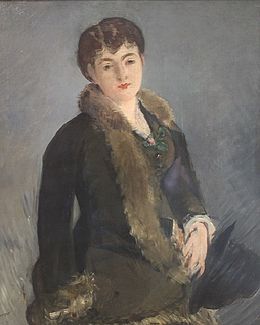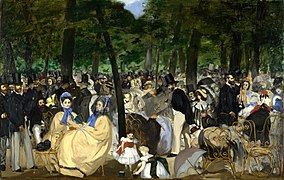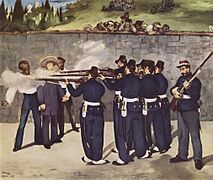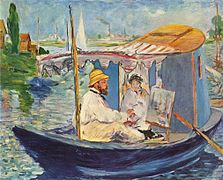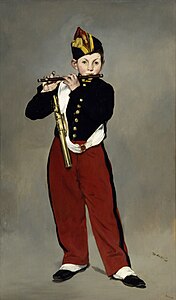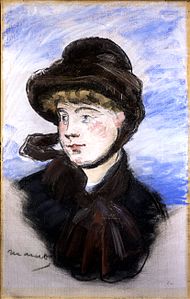Edouard manet
Édouard Manet (Paris, January 23, 1832 - Paris, April 30, 1883) was a French painter and engraver, renowned for his influence on the founders of Impressionism.
Biography
Early Years
He was born in Paris on January 23, 1832, into a wealthy family. His school days were uneventful and he finished his education without obtaining the necessary qualification to study law, to the disappointment of his father, who was a magistrate. His first contacts with art occurred at school.
At the age of sixteen, he traveled to Rio de Janeiro as a trainee sailor, intending to enter the French Naval Academy.
He is interested in art
With his father's consent, he decides to begin his studies in the Thomas Couture workshop. The classes were complemented with visits to museums. In 1856 he left the workshop as he considered the teacher's teachings outdated. He spent almost six years as a student of Thomas Couture, a very narrow-minded painter as a teacher. At the same time, he was able to copy paintings not only by Titian and Rembrandt, but also by Goya, Delacroix, Courbet and Daumier in the Louvre. De Couture learned that to be a great teacher, one must listen to the teachings of those who have been in the past. past
Travel around Europe
From 1850 to 1856 Manet dedicated himself to traveling around Europe to come into contact with the great painters of his time. He also visited Spain, being impressed with the customs, the folklore and the world of bullfighters.
Marries
On October 26, 1863, he married the Dutch pianist Suzanne Leenhoff, with whom he had had relations since 1850. Despite the marriage, the one who was almost certainly his son, León, born in 1852, continued to bear the surname of the mother, and passing for her brother. He is one of the characters in the painting Homage to Delacroix, which Henri Fantin-Latour painted in 1864.
Discover Diego Velázquez
In August 1865, he undertook a trip to Spain, organized by his friend Zacharie Astruc, in which he discovered Spanish Baroque painting, in particular Diego Velázquez, who would have an enormous influence on his work.
His only student
In 1869 he took Eva Gonzalès, daughter of a well-known novelist, who had been introduced to him by an art dealer, as his assistant. The young woman, who was not without talent but lacked initiative, was Manet's only student, who painted her in 1870.
Franco-Prussian War
At the outbreak of the Franco-Prussian War, Manet was mobilized along with other Impressionists. He sent his family to Oloron.Ste.-Marie, in the Pyrenees, and sent thirteen paintings to Duret, who received countless paintings by Manet, before entering the service of the National Guard as a lieutenant during the siege of Paris. After the declaration of the armistice in 1871 he formed part, along with fourteen other painters and ten sculptors, of the federation of artists of the ephemeral Paris Commune. He maintained good relations with the young impressionists, especially with Claude Monet; although he always resisted participating in independent exhibitions, he preferred to offer his works to the salon and exhibit them in his own studio if they were rejected.
First exhibition of impressionist painters
In 1872, Paul Durand-Ruel purchased twenty-four works by Manet for 35,000 francs and organized the first exhibition of Impressionist painters, although it was not commercially successful. However, among these artists a group conscience was emerging that would lead them to form the Société Anonyme des Artistes to carry out collective exhibitions.
Relationship with Monet
At this time, when he was closely associated with Monet, Édouard Manet began to adopt Impressionist techniques, although he refused to participate in group exhibitions. Instead, he organizes an exhibition of his works in his own studio on the Parisian street of St. Petersboug, which was quite popular, rumored at the time to have had some 4,000 visits.
Declining health
Around 1880, his health began to deteriorate due to a chronic circulatory problem that did not improve despite undergoing hydrotherapy treatments in Bellevue. At this time he was recognized for his talent with a second class medal awarded by the Salon and he was also made a Knight of the Legion of Honor.
Death
On April 20, 1883, due to his chronic circulatory disease, his left leg was amputated, and ten days later he died at the age of 51.
Artistic career
Of all the artists of his time, Manet was perhaps the most contradictory. Although considered a controversial and rebellious character, Manet spent most of his life seeking fame and fortune and, perhaps more importantly, a painter now accepted as one of the greats, he was often unsure of his direction. artistic and deeply hurt by the criticism of his work. He had to wait until the end of his life to achieve the success that his talent deserved. Despite being considered one of the fathers of Impressionism, he was never an impressionist in the strict sense of the word. For example, he never exhibited with the group and he never stopped going to the official Salons, even if they rejected him. He claimed that “he had no intention of doing away with old methods of painting or creating new ones.” His goals were not compatible with those of the Impressionists, however much they respected each other.
Manet's notoriety, at least in the early stages of his career, was due more to the subjects of his paintings, considered scandalous, than to the novelty of his style. It was not until the mid-1870s that he began to use impressionist techniques. In this sense, Bownes is quite convincing in showing that, as a young man, without quite considering himself an innovator, Manet was indeed trying to do something new: he was seeking to create a free type of composition that would nevertheless be as tightly organized on its surface as Like Velázquez's paintings.
In 1859 he presented his Absinthe Drinker to the Salon for the first time, a painting that made it easy to guess his adoration for Frans Hals, but which caused a turbulent reaction in the public and in the jury, undoubtedly inexplicable for a Manet who throughout his life the only thing he sought was success within respectability.
In the 1960s, however, his painting of a Spanish theme, so fashionable at the time in France, was quite well received and in 1861 the Salon accepted for the first time a painting of his, the Spanish Guitarist.
The general tone of Manet's work is not that of a radical painter solely concerned with the visual world. He is a sophisticated city dweller, a gentleman who conforms in every way to the nineteenth-century concept of dandy: a distant, refined observer, gazing at the spectacle around him from an elegant distance. From this point of view, Manet concludes what will undoubtedly be one of his most scandalous paintings, rejected at the 1863 Salon and exhibited at the Rejected Salon, Lunch on the Grass .
The challenge was posed by a contemporary reality, the bathers of the Seine, and the scene was reformulated in the language of the old masters (the painting is clearly inspired by Titian's Country Festival), competing with them and, at the same time, underlining the differences. Scenes with the theme of leisure in the countryside were already deeply rooted in Western art and abounded in popular illustrations as well as in academic art, but Manet's painting belongs to a different order, disconcerting in the evident immediacy with which it is presented. face the viewer.
However, despite the apparent unity of the group, each figure is a separate entity, absorbed in its own attitude or meditation, so that no kind of narrative connection can explain the whole. And this sensation of rupture makes the painting seem to disintegrate into a kind of collage of independent parts that only for an instant come together thanks to their borrowed resemblance to the Renaissance order.
But even more scandalous was the Olympia, painted in 1863 but not presented to the Salon until 1865, where it was rejected. Not least among the reasons why this painting was going to be shocking are the fact that it is not only a clear parody of a Renaissance work (Titian's Venus of Urbino), but also a flagrant description of modern sexual habits.
Manet replaces a Venetian goddess of love and beauty with a refined Parisian prostitute. But what really puzzled critics at the time is that Manet neither sentimentalizes nor idealizes her, and Olympias seems neither embarrassed nor dissatisfied with her work. She is not an exotic or picturesque figure. She is a woman of flesh and blood, presented with dazzling frontal lighting, on which the painter shows a disturbing detachment that does not allow him to moralize about her.
Both works excited the younger painters for what they implied in direct observation of contemporary life, for their naturalness and for their technical emancipation. Manet thus became, almost without wanting to, the main character in the group that met at the Café Guerbois, the cradle of Impressionism.
In 1867, around the time of the Second World's Fair in Paris, Manet, greatly discouraged by his poor reception at the official Salon, decided to follow Courbet's example a few years earlier and arranged, with his own money, a pavilion where He presented nearly fifty works without obtaining, however, any public success.
In the foreword to the catalog he was most likely assisted by his friend the novelist Zola because, in fact, for his painting throughout the 1860s, Manet relied on Zola's written support from his position as art critic at the weekly magazine L'Evenement. Under these circumstances Manet painted of him in 1867-68, a portrait at once strange and programmatic.
No painter from the Impressionist group has been as much discussed as Manet. To some he was the purest painter ever, completely indifferent to the objects he painted except as neutral excuses for contrasting lines and shadows. For others, he built symbolic cryptograms in which everything can be deciphered according to a secret but intelligible key. For some, Manet was the first genuinely modern painter to free art from his mimetic tasks. For others, he was the last great painter of the old masters, too rooted in a multitude of historical-artistic references.
Some still believe that he was a painter of poor technique, completely incapable of achieving spatial or compositional coherence. Others think that it was precisely these "defects" those that constituted his deliberate contribution to the drastic and enormously fruitful transformations that he introduced in the pictorial structure.
At the 1905 Salon d'Automne, an exhibition was held in recognition of the artist Edouard Manet.
Works
- A Parisian or woman with a coffee hat: In 1863 the face of a woman who looks in a provocative way will change the vision of art at the end of the centuryXIX.
- The surprised nymph (La Nymphe surprise) 1860, 146 cm × 114 cm, National Museum of Fine Arts (Argentina)
- Music in the Tuileries (La Musique aux Tuileries), 1862, 76 x 118 cm, National Gallery (London)
- Olympia, 1863, 130.5 x 190 cm, Orsay Museum (Paris)
- Lunch on grass (Le Déjeuner sur l'herbe), 1863, 208 x 264,5 cm, Orsay Museum (Paris). Also known by Almuerzo campestre
- Reading (The lecture), 1865-1873, 60.5 x 73.5 cm, Orsay Museum (Paris)
- Pyfane (Le Joueur de fifre), 1866, 161 x 97 cm, Orsay Museum (Paris)
- The execution of the Emperor Maximilian (L'Exécution de Maximilien), 1868, 252 x 305 cm, Städtische Kunsthalle (Mannheim)
- Portrait d'Émile Zola Portrait 1868, 146 x 114 cm, Orsay Museum (Paris)
- Lunch 1868, 118 x 154 cm, Neue Pinakothek, Munich
- The balcony 1868, 170 x 124,5 cm, Orsay Museum, Paris
- Monet on your boat (Monet sur son bateau) 1874, 50 x 64 cm, Neue Pinakothek, Munich
- Argenteuil 1874, 149 x 115 cm, Museum of Fine Arts (Tournai)
- Seine banks in Argenteuil (Banks of the Seine at Argenteuil) 1874, 103 x 62 cm, Courtauld Gallery (London)
- Authorport 1879, 83 x 67 cm, Private collection
- The Bar of Folies Bergère (Un bar aux Folies Bergère) 1882, 96 x 130 cm, Courtauld Institute (London)
- Carnations and clemátides in a glass jar 1882, 55 × 34 cm, Orsay Museum (Paris)
- Front Amazon, Museo Thyssen-Bornemisza, Madrid
- The asparagus, Orsay Museum (Paris)
Contenido relacionado
Nu metal
Peter Safar
Annex: II edition of the Goya Awards
